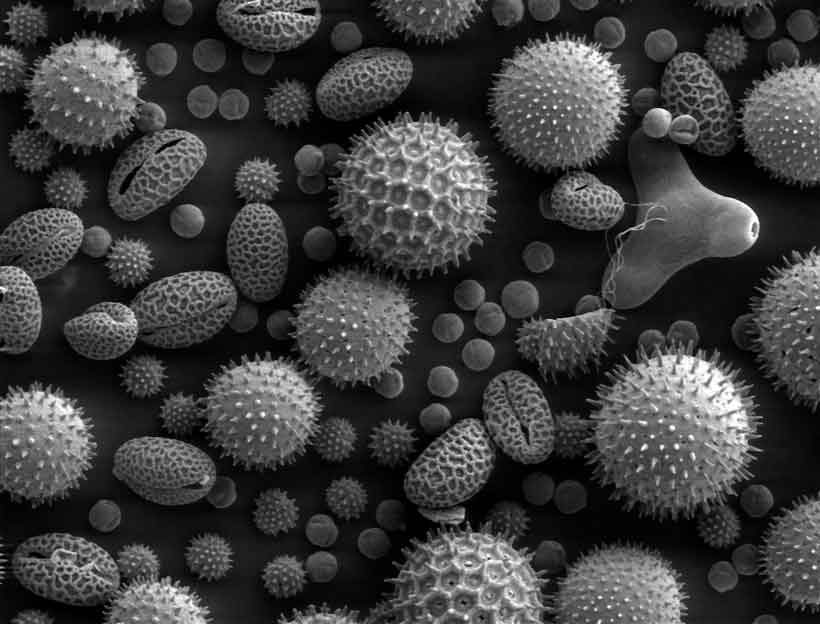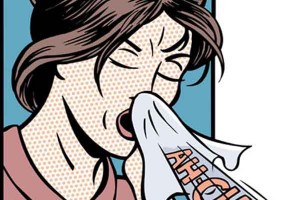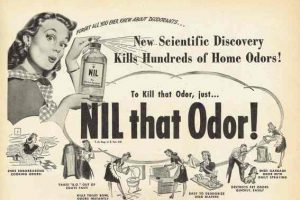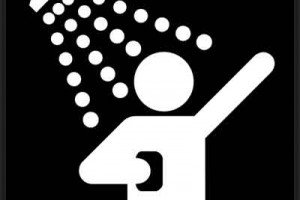I may get commissions for purchases made through links in this post.

It’s still a little known fact. Scary too if you think about it.
The reality that the air quality in your home is likely to be much worse than the air you breathe in when you step outside.
Yep, even in the city with its traffic and industrial areas.
It’s hard to imagine that the one place where we typically work the hardest to ensure cleanliness is, in fact, where our lungs, skin and immune system are really put to the test.
Unknowingly this contaminated indoor air has a devastating effect on your comfort and energy levels.
And even worse, it may cripple your health causing you to get ill.
Recent studies have revealed that, much of the time, our indoor air quality is anywhere from 2 to 5 times more polluted than the air outside our homes and, depending upon where and how you live, it can actually be up to 100 times more contaminated.
In order to answer the question, how to naturally clean indoor air we need to know about causes first.
Causes of poor indoor air quality
Some of this can be attributed to older homes with outdated materials and appliances in place, but newer homes are often just as bad.
As we’ve turned to more energy efficient building strategies over the past couple of decades, modern homes have become airtight in order to maintain comfortable indoor temperatures while using less power.
Unfortunately, one of the side effects of this trend has been that we are also sealing hazardous toxins, allergens, bacteria, and virus germs in with us.
With studies indicating that the average person spends about 90% of their time indoors, this means that we spend the vast majority of our day being exposed to what amounts to a stew of harmful elements.
Combined with the upswing in commercial cleaning products which contain dangerous chemicals in order to eradicate germs and odors, we are seeing more and more people suffering from reactions to their indoor environments.
These range from mild irritations to more serious conditions such as sinus infections, asthma and even life-threatening illnesses.
A wide range of chemicals and other toxins enter our homes on a daily basis. The irony is that they are often introduced by the same products that we use in an effort to keep our living areas clean and free of odors.
In fact, many of the most popular cleaning products contain chemicals and volatile organic compounds (VOCs), which can cause the air that we breathe in our homes to become quite dangerous to our lungs.
These toxins can also irritate our skin and flare up allergies, making it uncomfortable to spend time in the very place that we consider to be our refuge from the outside world.
If you’re worried about whether or not the atmosphere in your home is safe for you and your family, read on for a rundown of:
- the most common household toxins, pollutants, germs and allergens.
- The effects that they could have on your health and
- specific tips for getting rid of them.
A number of specific measures that you can take in order to avoid introducing these chemicals into your home and to help mitigate their effects if they are present.
How To Clean Your Home’s Air Naturally
In order to effectively rid your home’s air of contaminants it’s helpful to know what’s lurking. Sick makers and other unwanted particles can be divided in the following categories:
- Toxins and pollutants
- Allergens
- Bacteria and viruses
Tips To Reduce Indoor Air Toxins & Pollutants
1. Use Low-VOC Products
Volatile organic compounds can be found in everything from paints, stains and varnishes to household cleaners or textiles, and they can continue to emit harmful chemicals like acetaldehyde and formaldehyde for several months after they’ve been used, even if the odor has subsided.
This applies not only to products that are used for interior decorating, but also to paints and adhesives that are commonly used for arts and crafts.
Look for products that are labeled as low-VOC or no-VOC and even then, you should ensure that the space where they are used has adequate ventilation both during and after their application.
Also, be sure that you don’t store opened cans or bottles of any of these products in your home.
2. Use Natural Cleaners
There are plenty of commercial cleaning products on the market nowadays that are low-VOC, but there are also some totally natural products that people don’t realize make very effective cleaners.
Baking soda, white vinegar, hydrogen peroxide and club soda are all exceptionally useful for housecleaning, inexpensive and they can often work much better than the heavily-fragranced formulas that you buy at the store.
You can find a ton of recipes for making your own cleaners online these days and you may just find that you never need to buy commercial cleaning products again.
3. Let Your Dry Cleaning Breathe
Dry cleaning solvents are often toxic to breathe in and they can very quickly aggravate symptoms of asthma. You should let dry cleaned items air out out-of-doors, preferably overnight, before bringing them inside or wearing them in order to keep from introducing these solvents to your skin, home or other clothing.
4. Use Natural, Common Scents
Air fresheners and scented room sprays contain a lot of chemical pollutants. In fact, there are reports of adults actually passing out due to the use of some of these products.
Rely instead on pure essential oils in vaporizers or diffusers to freshen up your home or, even better, simmer cloves and cinnamon in a pot on your stove for a mild and inviting fragrance that won’t do damage to your airways.
5. Be Careful What You Burn
Petroleum-based candles with heavy perfumes can release a lot of toxins into your home, so if you just can’t resist the flickering flame that they put off, look for soy candles that contain less intense fragrance.
Also, if you have a wood-burning fireplace or stove, only burn wood that has been dried or cured and never pressure-treated, since it can produce lingering fumes that are irritating to the respiratory system.
6. Lookout for Lead Paint
This element is still found in homes that were built before 1978 and any chipping, peeling or chalking of lead paint can increase the threat of lead exposure.
Young children are especially susceptible to the harmful effects of lead, particularly if they are allowed to breathe in lead paint dust, which can cause serious and permanent damage.
If you do have lead paint in your home and it’s in good condition, it’s generally considered best to leave it alone unless and until you see signs of wear.
No matter what, it’s never a good idea to sand or burn off paint that may contain lead. For those people who work with lead due to their job or a hobby, they should use doormats and change clothes before entering their house to keep the risk of bringing it into their home to a bare minimum.
7. Wash and Air Out New Items
New drapes, upholstery, pillows and linens can all contain residual chemicals from the manufacturing process, so always make it a point to wash new sheets, blankets and towels before putting them to use.
Curtains, pillows and upholstery should be aired out thoroughly before coming into your home in order to reduce the amount of VOCs that make it through the door with them.
8. Adjust Your Burners
If you have a gas stove, an annual adjustment to the burners can keep them from putting off harmful gases every time that you cook. Remember that the flame tip should always be blue, so if you’re seeing a yellow flame tip, it’s definitely time for a tune-up.
In addition, make sure to keep your burners clean in order to cut down on the amount of fumes that they put off. Last but not least, never use a gas stove as a means to heat your home.
9. Use Non-aerosol Personal Care Products
Deodorant, hairspray and body sprays that come in aerosol cans emit gases that non-aerosol formulas don’t, so switching to a pump spray version of any of these products will almost always be an improvement.
No matter what type of personal care products you use, turn on an exhaust fan or open the door or window to avoid overwhelming your respiratory system with fragrance and other chemicals.
10. Ask Smokers to Step Outside
Smoking cigarettes indoors leaves behind a slew of harmful fumes and chemicals that can irritate asthma and cause lung disease, even for nonsmokers who breathe them in.
Children and elderly people are especially susceptible to the effects of secondhand smoke, so if they are members of the household or regular visitors, this measure is crucial to their health and comfort.
11. Ventilate Fireplaces & Stoves Outdoors
Since fireplaces and wood or gas-burning stoves can produce harmful chemicals like carbon monoxide, nitrogen oxides and fine particle pollution, ventilation from these features to an area that is outside of your home is an imperative.
The EPA has determined that cooking a single meal on a gas stove can create levels of nitrogen dioxide that are unsafe for anyone to breathe, so you should always ventilate your kitchen when cooking if you rely on one of these appliances.
12. Beware of Formaldehyde
This gas can be found in many of the most popular home products on today’s market, from disinfectants and insecticides to adhesives that are commonly used in particle board.
Formaldehyde is a carcinogen and is known to cause health problems like coughing, eye, nose and throat irritation, skin rashes and difficulty breathing, so those who suffer from asthma are very often more sensitive to its ill effects.
You can go a long way toward keeping this chemical out of your home simply by choosing wood panel products that don’t rely on formaldehyde glues, lumber or other materials.
Cigarette smoke is also a major source of formaldehyde, which provides yet another very good reason to ban indoor smoking from your home altogether.
13. Get Rid of Pests Safely
Pesticides carry many harmful chemicals, so the best way to keep your home free of pests and toxins at the same time is through the practice of integrated pest management.
Block holes leading to crawlspaces or outside, keep food containers closed tightly and clean up crumbs or spills promptly.
Also, be sure to cover your trash cans and take the trash out often. If you do have an infestation, use bait traps that capture pests rather than sprays or foggers and get professional help from a service that uses green products if the problem is getting out of hand.
14. Beware of Beauty Supplies
Cleaning products and building materials aren’t the only culprits when it comes to VOC emissions. Hair and nail products are also often loaded with these toxins in the form of fragrance, dyes and other chemical ingredients.
If you can, try to avoid the use of any product that is heavily fragranced, including shampoo, conditioner, soap, body wash and nail polish or remover.
Artificial nail glue can also be a major source of VOCs, so if you apply them at home, always employ extra caution. Use only those items that are specifically labeled as low-VOC and be sure to open windows and use exhaust fans anytime that they are open.
15. Cut Your Engines
Leaving a car, motorcycle or lawn mower running in your garage, even for a couple of minutes, can introduce carbon monoxide and other byproducts of combustion into your home’s air. Turn off your vehicle’s motor as soon as you enter your garage and never close the garage door before doing so.
If you have a safe place besides a garage that is attached to your house where you can park your car or bike, that’s all the better for the overall air quality in your home.
16. Treat Your Landscape Naturally
When you employ the use of chemical pesticides and fertilizers to treat your lawn or landscape, they are often tracked inside your home and these products can be extremely harmful to both the skin and the lungs.
Always make it a point to wash your hands, clothes and shoes if you do have to use them and try to rely on all-natural strategies for lawn and landscape management whenever it’s possible. The archaic use of companion planting is a green and effective way of enhancing your yard too.
17. Test Your Home For Radon Gas
Be aware of the hazards of radon, a silent, odorless gas that is the 2nd leading cause of lung cancer after cigarette smoking. Since radon is a gas that is most often found in the soil surrounding your home, it usually makes its way in through cracks in a basement floor, poorly-fitted pipes or at construction joints, like where the floor and the wall meet.
These days, there are inexpensive and reliable tests available that can quickly detect radon gas in your home, so having one is a natural first step in determining whether or not your household is being exposed to this dangerous and potentially life-threatening element.
18. Leave Asbestos Removal to the Pros
Don’t disturb asbestos, a mineral fiber that is present in a lot of older homes, since tiny asbestos fibers in the air can increase the risk of lung cancer and other respiratory diseases.
This substance is most often found in pipe coverings, flooring, shingles and roofs and while you’ll definitely want to check on these elements regularly for signs of damage, any repairs that do need to be made should only be performed by a professional who has the proper training and equipment.
Tips To Reduce Airborne Allergens, Mold, Dust Mites
Airborne allergens can come in many forms as well- including dust mites, mold and pet dander- and any one of these can quickly wreak havoc on the eyes, skin, lungs and immune system.
This is another area where asthmatics tend to suffer the most, so if you or a member of your household has this condition, it’s doubly important that you keep these irritants in check.
Researchers have only become aware of how harmful mold really can be to human health over the last couple of decades, but it has quickly gained a reputation for being one of the most serious causes of Toxic Home Syndrome, wherein a residence can become uninhabitable due to negative health effects.
Some conditions caused by mold and certain bacteria, such as organic dust toxic syndrome (ODTS), can be severe. Additionally, some molds and fungi are known to be sources of mycotoxins—toxic secondary metabolites that can become airborne on dead fungal fragments or attached to dust particles. Mycotoxins can affect protein synthesis, damage DNA, and inhibit the immune system. They can also irritate skin and the linings of the mouth, esophagus and intestines if ingested (Husman, T., 1996).
While keeping the surfaces of your home relatively clean will certainly help to eliminate some of these irritants, there are plenty of other steps you can take that will go just as far to counteract their presence and their effects.
8 Simple Steps To Reduce Airborne Allergens In Your Home
19. Use Filters
Many airborne allergens can be contained through the use of HEPA filters on appliances, and HVAC systems. HEPA stands for High-Efficiency Particulate Arrestance and these filters are now often found on vacuum cleaners and air purifying devices.
For many people, these devices are crucial upgrades to the household. Not only are they critical for or those who are susceptible to respiratory ailments, heart problems, colds, bacteria and viruses.
These devices are highly beneficial as they reduce the incidence of headaches, irritation of the respiratory tract, nausea and difficulty concentrating.
Recent research indicates that impure air in your home may encourage cancer growth as well.
Since vacuuming can blow dust and allergens into the air, a good HEPA filter in place makes especially good sense. They remove airborne dust, allergens, germs and odors.
Consider getting a home air purifier with a Hyper HEPA filter with 90%+ efficiency such as the best selling GermGuardian AC4825. It’s a model with easy to change filters, an additional pre-filter system that operates quietly and low energy consumption.
Keep in mind that, no matter what appliance they are used on, they’re only effective if they’re cleaned or changed out on a frequent basis, so be sure to maintain a regular replacement schedule if you want to maximize the benefits of using a HEPA filter.
20. Get a Himalayan Salt Lamp
These popular lamps emit an amber light that not only gives your home a warm atmosphere but they purify the air too. Natural crystal salt lamps as they are called as well emit negative ions that fight against positively charged particles that cause you to feel sluggish and stuffy.
The lit salt crystals clear your home’s air naturally of allergens like pet dander, smoke, pollens, and other air pollutants.They also fight odors. Popular among asthma and sinusitus sufferers, as well as many others. Read raving user reviews for more benefits.
21. Wash, Don’t Dust
Any time that you dust your furniture, windowsills and knick-knacks with a dry rag or feather duster, it not only doesn’t get rid of the dirt and grime that are on them, but it actually sends it into the air or onto the ground, where it’s likely to be kicked up or picked up by your feet the next time that you pass through.
That’s why washing your surfaces with soap and water instead is a much more effective method for reducing the amount of dust and allergens in your home. These elements are captured by the water and they wind up going down the drain, rather than becoming just another airborne contaminant.
22. Control Humidity
Moisture is a breeding ground for mold and mildew, so ensuring that there is proper ventilation in the kitchen, bathroom and basement of your home is exceptionally important. Ideal humidity is healthier and saves you money.
Opening windows or installing vents can help, as can exhaust fans and dehumidifiers. Many people nowadays rely on air humidifiers in order to increase the amount of moisture in their homes for comfort, but these appliances can create dangerous levels of humidity in rooms that are closed off from the rest of your home.
Check the levels of any room that you are using one of these devices in to make sure that the humidity remains below 50% at all times. Make sure to read these 19 tips on how to reduce humidity at home.
23. Clean Your Home’s Vents and Fans
The AC and heating vents throughout your home are susceptible to a dangerous buildup of dust, pollen and other allergens from outside.
Regularly cleaning these systems and their vents, as well as making an effort to keep your dehumidifier and fans clean, will help to keep outside pollutants from being blown into your inside air.
It can be very easy to miss the dust that collects on ceiling fans especially, so it might help to setup a schedule for cleaning the blades and motor of these devices.
24. Take Care of Mold Early On
The best time to confront a mold problem is before it starts, since it can be exceedingly difficult to completely get rid of it once it begins to take hold. That’s why it is always advisable to fix a leak as soon as it is spotted and to inspect for mold right away anytime that you do have one.
If a mold infestation is discovered, you should take the appropriate measures to eradicate it immediately, due to the fact that mold is able to spread very quickly. Any and all materials that have been contaminated with mold should be properly disposed of as well, due to the fact that if even a little bit is left behind, it can rapidly reoccur.
There are spores of many different molds in the air of houses and nonindustrial workplaces. The most common are likely to be species of Cladosporium, Penicillium, Aspergillus and Eurotium. These molds and fungi colonize substrates, forming networks of filamentous mycelia, which then produce sporing structures which produce numerous aerially dispersed spores, adding to the indoor air bioburden. Yeasts are also found in most indoor air samples, and may be present in large numbers under the right conditions (Flannigan, B., 2011).
For severe mold problems, it may be necessary to call in a professional contractor to ensure that it hasn’t contaminated your flooring, ceiling or walls.
25. Clean Up After Your Pets
Many people are under the mistaken impression that pet allergies are caused solely by the animal’s hair, but the reality is that there are allergens in your pet’s saliva, urine, feces and dead skin cells as well.
This means that, no matter what a breeder might claim, there is no such thing as a truly hypoallergenic pet. Be sure to clean floors and upholstery at least a couple of times per week to remove as much of the pet dander as possible and reduce allergy symptoms.
Keeping your pet well-groomed can help with this problem too, so don’t skip regular baths. If you comb their hair out, be sure to do it outside in order to avoid their dander from becoming airborne in your home.
26. Kill Dust Mites
Dust mites live in the bedding, pillows, mattresses, stuffed toys, upholstery and carpets of our homes and these little critters thrive in warm, humid conditions.
You can kill them off by keeping humidity levels at less than 50% with the use of a dehumidifier, as well as vacuuming and steam cleaning your upholstered furniture and curtains.
Use hot water anytime that you wash bedding or toys, and make it a point to replace pillows on a regular basis. Also, remove carpeting or rugs and use dust mite-resistant covers wherever you can. Keep in mind that, no matter how tidy and clean you are, house dust mites live in all homes.
Hypoallergenic mattress covers are a very effective way to help you prevent your mattress from becoming infested with mites and their droppings. These protectors also keep your airways free from dust mite droppings already present in older mattresses. The mattress protector prevents the particles from disperses into the air.
27. Ventilate Appliances Outside
Laundry rooms and central vacuum cleaners can blow dust and other allergens into the air, especially if they aren’t properly ventilated.
Ensure that appliances like clothes dryers and central vacuum cleaners are exhausted outside your home instead of into another room of your house.
Tips On How To Reduce Bacteria & Viruses
Some of the most harmful pollutants in our homes are living organisms like bacteria and viral germs that can cause illnesses or infections.
While all of us are hosts to millions of harmless germs that can actually be quite helpful in fighting off illness, we also carry a wide range of germs that are capable of making us and those around sick with a cold or the flu or that can aggravate respiratory illnesses like asthma.
Although there are obvious sites, such as bathrooms or kitchens, where certain types of germs are surely more likely to congregate, what most people don’t take into account is that a good number of germs are present in our mucus, saliva and skin cells as well.
Substrates where microbes such as bacteria, fungi and viral germs might grow include materials such as wood, surface coatings such as wall paper and paint, soft furnishings such as carpets and upholstered furniture, soil in plant pots, dust, skin scales, hair and secretions of human beings and other animals; and cooked foods and their raw ingredients.
Every time that you cough, sneeze, talk or even breathe, you are emitting germs that, if they contain bacteria or viruses, have the potential to make other members of your household ill, regardless of whether or not you are showing symptoms.
28. “Take off your shoes please?”
The cultural tradition of taking off shoes when entering a home is grounded in common sense. E. coli, meningitis and Kebsiella pneumonia are just a few of the bacterial germs and microbes that were discovered on shoes in a study that was conducted by the University of Arizona.
In fact, the researchers found that there were more than 400,000 units of bacteria on the outside of the subjects’ shoes, all of which have the capability of turning carpets and flooring into something of a giant Petri dish.
On top of that, footwear tracks in more dirt, which means that more cleaning products are required, raising the potential for more harmful chemicals to be introduced to your household.
29. Use Doormats
If you absolutely must wear your shoes indoors or if you don’t like the idea of asking visitors to your home to remove theirs, the simple act of using a doormat before entering the residence can reduce the number of germs that are carried in on shoes tremendously.
Bear in mind that doormats can become very dirty with use, so they must be cleaned or changed out regularly, something that few homeowners consider.
Use soap and hot water to wash your doormat and allow it to dry out completely before using it again, since wiping dirty shoes on a wet surface can create a veritable hotspot for bacteria.
30. Avoid ‘The Air Travel Cold Syndrome’ – Improve Your Home’s Air Circulation
Ever heard of how much higher your odds are of getting sick when you’re on an airplane? Research indicates your chance on catching a cold on a plane is about 20%.
The re-circulated air that is pumped through the cabin of the plane is the primary reason for this and the same can be true of the air in your home.
Ensuring that your home has proper ventilation throughout is a critical part of any fight to improve your indoor air quality. Stagnant air makes it much easier for bacteria and viruses to survive and spread, so look for ways that you can introduce fresh air and keep it moving.
Whether it’s through the use of open windows or fans, good air flow will reduce the level of harmful germs and can help to eliminate odors, fumes and humidity at the same time.
It’s true, most planes have HEPA filters that will capture 99.97% of bacterial and virus-carrying particles but these are switched off during boarding, exiting and stops. Which is when infections among passengers spread like wildfire.
31. Watch Out for Condensation
Since most microbes thrive in moist conditions, it’s definitely best to find and confront dampness before it becomes a serious problem.
According to the World Health Organization, long-lasting condensation on windows and other surfaces can be an early indicator that there isn’t enough ventilation in a particular area of your home. When you do see it, try to find the source of the moisture and remedy it as soon as possible.
The occurrence of microbial growth is dependent on moisture availability. Bacteria must have saturated surfaces, or water (like in HVAC drain pans, reservoirs, etc.). Some molds also require conditions of near saturation, but others only require damp surfaces in order to grow. (Flannigan, B., 2011).
32. Keep an eye out for hot water sources
A common bacterium affecting human health is the one that causes Legionnaire’s Disease, Legionella pneumophila. This pathogen is found in hot water supplies, HVAC systems, humidifiers, respiratory therapy equipment, Jacuzzis, spas, and shower stalls. It is spread to humans via aqueous aerosols (Flannigan, B., 2011).
33. Avoid Infestations
This applies to areas both inside and outside your home and includes any pest or rodent that could be carrying a disease.
Rats, mice, cockroaches and pigeons all fall into this category, so even if you only see one or two of them in or around your home, it’s best to take precautionary measures to get rid of them as quickly as you can.
Hantavirus, leptospirosis, encephalitis and E.coli are just a few of the diseases that can be transmitted from these animals to humans and since they often nest in areas where people live, they have the potential of posing a very serious threat to our health.
Traps or bait are generally the effective if you only have a few, but for a true infestation, you may need to call in a professional.
General Tips & Measures
Aside from all of these guidelines to help reduce specific contaminants in your home’s environment, there are a few measures that you can take to improve your indoor air quality in general.
34. Know the Limits of an Air Purifier
While these machines can reduce tiny airborne particles and reduce indoor pollution, they shouldn’t be relied upon to remove gases or reduce humidity in your home.
Also, larger particles that are heavy, which includes many allergens, will generally fall out of the air too quickly to be effectively removed this way. If you do decide to use an air purifier, be sure that you choose one with the capacity to clean at least, if not more than, the square footage of the largest room in your home.
35. Reduce Textiles
Rugs and carpeting trap unhealthy particles, including chemicals, dust mites, pet dander, dirt and fungi. Even worse, the very necessary process of vacuuming will almost inevitably cause these pollutants to become airborne.
Washing rugs is much more effective, but when it comes to carpeting, it can be tough to eliminate all of the pollutants deep within them on a regular basis.
Wood or tile flooring makes a good alternative, since it won’t hold on to contaminants and can easily be cleaned with water and a damp cloth or sponge. In this same vein, switching from drapes or curtains to blinds can also provide you with cleaner air, since fabric tends to hold onto germs and other pollutants more readily and blinds are easier to clean.
36. Perform An Annual Inspection
Every year, you should check your attic, basement and foundation for leaks that could be allowing radon gas or moisture to create problems in your home.
Look for missing shingles that could be allowing rainwater to enter your home or cracks in the walls, flooring and pipes where moisture or radon could seep in. Even a small leak can create some very big problems, so don’t ignore a little crack because it seems insignificant.
Water-damaged buildings can contribute to a higher incidence chronic bronchitis. The moist environments inside can create conditions where pathogens can thrive and multiply (Husman, T., 1996).
37. Get Some Houseplants
It is widely claimed that a number of common houseplants can help clearing the air of VOCs and other harmful elements, providing an easy and appealing way to improve your home’s air quality. There are however some limitations to their air purifying ability.
Aloe vera processes benzene efficiently and pothos and sansaverias have been shown to reduce formaldehyde. Meanwhile, spider plants can help to get rid of carbon monoxide, an odorless and potentially lethal gas.
A dracaena marginata is especially useful when it comes to eliminating xylene and perennial favorite English ivy has proven helpful in reducing airborne fecal particles.
There are dozens of houseplants that can help with indoor pollution, so keeping them around makes sense both for aesthetics and your health.
38. Location, Location, Location
If you have a choice in the matter, place your home’s HVAC, furnace and ductwork in areas where they won’t inadvertently draw harmful pollutants into your home.
This means out of the garage or a closet and definitely not in an area with poor ventilation. A dedicated utility room with outdoor exhaust is the most preferred spot for these appliances.
Final thoughts
Studies show that in the NYC area, since the 1990’s the amount of sinusitus cases has been increased significantly. The reason? Nobody knows. So in order to take care of ourselves and our family members, being diligent without becoming paranoia is probably the wisest thing to do.
Indoor air can be contaminated with bacteria, molds and fungi, and occasionally, viruses and protozoans. These can cause a myriad of health effects, including irritating and allergic conditions and pulmonary diseases.
Additionally, molds and fungi can add mycotoxins to the indoor air environment, which are attributed to many different metabolic conditions. The best ways to mitigate the airborne bioburden inside a building is to make the indoor environment less habitable for microbes.
- Make sure HVAC systems are optimally maintained and running, with proper filtration (try and keep the indoor relative humidity below 70%).
- Remove sources of water infiltration and accumulation.
- Keep surfaces clean and dust-free, and remove mold-contaminated porous surfaces.
- Proper air conditioning and a clean and disinfected indoor environment will go a long way toward reducing the allergies and respiratory conditions caused by airborne microbes and the spores and mycotoxins created by molds and fungi.
Although many of the most common symptoms associated with poor indoor air quality like headaches, trouble breathing or itchy skin or eyes will disappear as soon as a contaminant is removed from the home, some of the most serious side effects of breathing in polluted air may not show up for many years.
Cancer, heart disease and chronic respiratory illness can all be linked to long-term exposure to airborne toxins, allergens or germs which could easily be controlled through the use of simple, everyday lifestyle changes.
While it would be very nearly impossible to rid the air in your home of every last impurity, there’s no doubt among experts that if you are conscious of how your habits and behavior can impact your indoor air quality, it’s actually quite easy to maintain an environment that is cleaner and more healthful for both your comfort and your long-term health.
The most common and dangerous indoor pollutants are things like carbon monoxide, which kills some 400 people and sickens thousands annually and secondhand smoke, which is known to cause respiratory tract infections in children and is capable of making cardiovascular and lung illnesses in adults much worse.
References
Husman, T. (1996). Health effects of indoor air microorganisms. Scand J Work Environ Health 22(1), 5-13. doi:10.5271/sjweh.103
Flannigan, B. (2011). Biological Contamination. In Stellman, J.M. & Guardino Solá, X, (Eds.), Indoor Air Quality, Encyclopedia of Occupational Health and Safety. Geneva: International Labor Organization.
WHSCC. (2000). Microbials and Indoor Air Quality. Retrieved from WHSCC.
Image: Wikimedia Commons.
























If you find it difficult to stop smoking by yourself,
speak with a medical professional. Data shows that close to 40% oof people who manage to stay
smoke free for a year relapse and go on to smoke a cigarette or more in thhe future; although this proability does go down considerably for people who have been smoke free for around
five years. Your blood pressure may also rise quite substantially if
you’re using lobelia.
really liked this article! One of the few where it says that you need to clean the air ducts! I read a little more about it here, a small addition to this excellent article. http://airductdallas.com/facts-figure-one-clean-airduct-infograph/. Just to understand a little more.
About how the airway gets dirty I learned in detail from this article https://www.epa.gov/indoor-air-quality-iaq/should-you-have-air-ducts-your-home-cleane. Before I did not even think about this danger. Dirty air ducts can cause huge damage to the health of the whole family. You can get allergies, lung diseases, asthma and even cancer! But very few people know about it! It is necessary to search for more information about these diseases and their causes. I hope that such articles as this one can help people prevent illness.